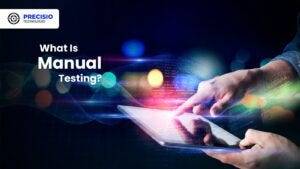#manual software testing
Explore tagged Tumblr posts
Text
The Technical Backbone of Manual Testing Services: Tools, Techniques & Strategies
Despite the rise of automation and AI, manual testing services remain the backbone of comprehensive quality assurance. They bring in the human element—intuition, experience, and empathy—which no machine can replicate. At Robotico Digital, we combine this human edge with technical precision, delivering high-quality manual software testing that safeguards your product, enhances user satisfaction, and ensures market readiness.
0 notes
Text
Reliable Manual Software Testing Services for Quality Assurance
Manual software testing is an important process that involves detailed checking of the software for errors, bugs, or performance issues without the assistance of automation tools. It guarantees that every feature of the software functions as expected for a smooth user experience. Our expert testers follow structured processes to identify problems, verify fixes, and maintain quality standards. Choose manual software testing for deeper insights and result-oriented results and make your software robust and user-friendly. Contact us today for professional manual software testing services!
1 note
·
View note
Text

#software testing services#software testing software#ai software testing#security testing in software testing#software testing consultancy#testing in software engineering#quality assurance in software testing#manual software testing
0 notes
Text
Manual testing is a process in the software development cycle in which testers accomplish test cases manually. This approach allows human testers to thoroughly test software’s functionality, usability, and compatibility to identify any errors early. However, this must rigorously follow manual testing best practices, ensuring premier software quality.
In this article, we will explore the manual testing best practices for enhanced software quality and user experience. So, without further ado, let’s get started.
0 notes
Text

best software testing course in trichy
#best software testing course in trichy#manual testing#automation testing#automation software#manual software testing#selenium
0 notes
Text
Discover the important role of software testing in ensuring the success and reliability of business applications. Learn how effective software testing improves trustworthiness and user interface and reduces security risk.
0 notes
Text
Manual Testing Service Strategies for DevOps Teams

In today’s fast-paced software development landscape, where continuous integration and continuous delivery (CI/CD) are the norm, DevOps teams play a crucial role in delivering high-quality software at an accelerated pace. While automation testing has gained popularity, manual testing services remain an indispensable component of the quality assurance process. Manual testing services, also known as Manual QA Testing Services, Manual QA Services, or Manual Software Testing, provide a human touch that complements automation testing. In this blog, we will explore the importance of manual testing services in DevOps and strategies to effectively incorporate them into your development pipeline.
Understanding Manual Testing Services
Manual testing services involve the systematic and meticulous testing of software applications by skilled testers who simulate real user interactions. This approach helps identify subtle usability issues, accessibility concerns, and non-functional aspects that automated tests may overlook. Manual QA testing solutions requires human judgment, creativity, and intuition to uncover defects that automated scripts may miss.
Why Manual Testing Services are Vital in DevOps
User-Centric Testing: Manual testing services focus on the end-user experience. Testers can evaluate how an application behaves in real-world scenarios, ensuring it meets user expectations.
Exploratory Testing: Testers can conduct exploratory testing, where they actively explore the application to uncover defects that might not be covered by predefined test cases.
Usability Testing: Manual QA testing services assess the application’s usability, identifying design flaws and suggesting improvements to enhance user satisfaction.
Accessibility Testing: Ensuring that your Manual Software Testing is accessible to all users, including those with disabilities, is essential. Manual testers can validate compliance with accessibility standards.
Compatibility Testing: Manual testers can verify the compatibility of your application across different browsers, devices, and operating systems.
Countinue read here…
#manual testing services#Manual Software Testing#Manual QA testing services#Manual QA testing solutions#Manual QA Services
1 note
·
View note
Text
Automated Testing vs. Manual Testing: Which One is Right for Your Project?

Achieving high-quality, reliable software stands as a fundamental requirement in software development. Successful testing functions as an essential tool to discover faults and build performance capabilities that create better user experience outcomes. Two main testing methods dominate the field: automated testing and manual testing. The process of quality software assurance uses different testing approaches that demonstrate their own advantages as well as weaknesses according to specific project requirements and scenarios. We will explore the specifics to determine which testing process works best for your system development efforts.
1. What Is Manual Testing?

Manual testing involves a human tester manually executing test cases without using automation tools. Key Characteristics:
The methodology focuses its efforts on user interface together with usability and experience testing.
Human-centered applications where selection requires discretion include ad hoc testing and enumerative testing as well as examinations that need human evaluation.
Human performers are required during this approach; thus, it demands substantial time.
2. What Is Automated Testing?

Software performing automated testing executes test cases through workflows and helpers. Key Characteristics:
Efficient for repetitive and regression testing.
Users must spend money on tools along with developing custom scripts for testing.
Reduces human error.
3. Advantages of Manual Testing

Human Intuition: Software testing professionals can detect kernels through their human cognitive ability that automated tools cannot match. The observation and evaluation of visual elements runs more efficiently through human operatives instead of advanced tools.
Flexibility: This method suits exploratory testing specifically because there are no pre-determined scripts available.
Low Initial Investment: Running this approach does not need tool purchases or applications to develop automation frameworks.
Adaptable for UI/UX Testing: Running this approach does not need tool purchases or applications to develop automation frameworks.
4. Advantages of Automated Testing

Speed: Executes repetitive tests much faster than humans.
Scalability: The system proves most effective for extensive projects that need constant system updates.
Accuracy: When performing recurring actions, automated systems minimize the chances of human mistakes.
Cost-Efficient in the Long Run: Once established and implemented, the system demands costly investments but ensures continuous development expenses decrease over time.
Better for CI/CD Pipelines: Such testing technology connects various development pipelines that support agile and DevOps methodologies.
5. Disadvantages of Manual Testing

Time-Consuming: The manual performance of repeated tests leads to delayed completion of projects.
Error-Prone: Large applications contain tiny bugs that human testers commonly fail to detect.
Not Ideal for Scalability: The process of increasing manual testing needs additional testers to avoid cost escalations.
6. Disadvantages of Automated Testing

Initial Costs: Organizations must provide high financial resources to procure testing tools together with developing programming constructs.
Limited to Pre-Defined Scenarios: These testing approaches work poorly for handling exploratory or ad hoc testing.
Requires Maintenance: Test scripts need frequent updates when application changes occur.
Not Suitable for UI/UX Testing: Struggles with subjective user experience evaluations.
7. When to Use Manual Testing

Small Projects: The testing method proves beneficial at a low cost for small applications and provides quick assessments.
Exploratory Testing: Testing this approach benefits projects whose scripts have not been defined yet or need evaluation for newly added features.
Visual and Usability Testing: Performing assessments on interface components together with design features.
8. When to Use Automated Testing

Large Projects: Handles scalability for projects with frequent updates.
Regression Testing: Program testing becomes more efficient through automation since automated assessments perform multiple tests following each update process.
Performance Testing: The system performs efficient capabilities to conduct load testing and stress testing.
Continuous Development Environments: Agile progression and DevOps implementations need automation as a core requirement.
READ MORE- https://www.precisio.tech/automated-testing-vs-manual-testing-which-one-is-right-for-your-project/
2 notes
·
View notes
Text
#automation testing#manual vs automation#automation vs manual#manual testing#software testing services
2 notes
·
View notes
Text
The Technical Backbone of Manual Testing Services: Tools, Techniques & Strategies

In the fast-paced world of software development, quality assurance remains a non-negotiable pillar for successful product delivery. While automation dominates conversations around testing, manual testing services continue to play an essential role in identifying usability issues, design inconsistencies, and critical bugs that automated scripts might overlook. At Robotico Digital, we believe that manual software testing is more than just clicking through applications—it’s a craft driven by experience, intuition, and a structured methodology.
In this article, we explore the technical backbone of manual testing services, focusing on the tools, techniques, and strategies that make them indispensable in any robust QA framework.
Understanding Manual Software Testing
Manual software testing refers to the process where testers manually execute test cases without using automation tools. It involves evaluating the software from the end-user perspective, simulating real-world scenarios to identify bugs, inconsistencies, and performance bottlenecks.
While automation is ideal for repetitive tasks and regression suites, manual testing excels in exploratory testing, user interface (UI) validation, and usability assessments. It remains the go-to approach in early development stages, rapid iterations, and scenarios requiring human judgment.
Why Manual Testing Services Still Matter
Despite advancements in AI-powered testing and test automation frameworks, manual testing services continue to be indispensable for several reasons:
Human-Centric Validation: Only a human tester can truly judge the intuitiveness, accessibility, and user experience of an application.
Flexibility in Testing: Manual testing allows for on-the-fly testing during ad hoc and exploratory phases.
Cost-Effectiveness for Small Projects: For startups or MVPs, manual testing offers a quick and economical way to ensure quality.
UI/UX Assessment: Layout issues, visual defects, and navigational problems are more effectively caught through manual exploration.
Unscripted Scenario Coverage: Unpredictable test cases that haven’t been automated yet can be tackled manually.
Core Techniques in Manual Testing
To deliver reliable and accurate outcomes, manual testing services leverage a mix of structured and adaptive testing techniques. At Robotico Digital, we apply the following core techniques based on project requirements:
1. Black Box Testing
Testers evaluate the application without any knowledge of its internal code structure. Focus areas include functional specifications, input/output validation, and behavior under different scenarios.
2. White Box Testing
Although less common in manual testing, this technique involves some understanding of the internal logic. It’s useful for unit testing and integration testing done manually by developers or QA engineers.
3. Exploratory Testing
This informal yet powerful approach relies on the tester’s creativity, domain knowledge, and analytical skills. It’s especially useful when documentation is minimal or constantly evolving.
4. Regression Testing
As software evolves, previously working features can break. Manual regression testing ensures new updates haven’t negatively impacted the existing functionality.
5. Usability Testing
Manual testers simulate end-user behavior to assess user-friendliness, accessibility, and overall user satisfaction with the software interface.
Test Design Strategies in Manual Testing
Effective manual testing requires well-designed test cases that cover all functional and edge-case scenarios. At Robotico Digital, we use the following strategies to optimize our manual testing services:
1. Requirement-Based Test Case Design
We create test cases derived directly from requirement specifications and user stories to ensure each business logic is validated.
2. Boundary Value Analysis (BVA)
This technique tests input values at their edge limits. It’s crucial in detecting off-by-one errors and buffer overflow vulnerabilities.
3. Equivalence Partitioning
Inputs are grouped into valid and invalid partitions to minimize redundant test cases while maintaining optimal coverage.
4. State Transition Testing
We test how the application behaves based on different inputs and system states—ideal for workflow-driven software like CRMs or booking systems.
5. Decision Table Testing
We evaluate combinations of inputs and their corresponding actions, helpful in applications with complex business rules or conditional logic.
Essential Tools for Manual Testing Services
Though manual testing doesn’t rely on automation scripts, testers still need powerful tools to track test cases, report bugs, and manage testing processes. Below are some of the tools used by the manual software testing team at Robotico Digital:
1. TestRail / Zephyr / TestLink
These test management tools help document, organize, and track test execution, making the process more structured and traceable.
2. JIRA / Bugzilla / Mantis
Issue tracking tools are indispensable for logging bugs, assigning priorities, and collaborating with development teams to resolve issues efficiently.
3. Browser Developer Tools
For web testing, Chrome DevTools or Firefox Developer Tools are essential for inspecting elements, debugging front-end issues, and monitoring network activity.
4. Postman / Swagger
Though commonly used in API automation, these tools also help manual testers validate APIs by manually triggering endpoints and checking responses.
5. Virtual Machines & Emulators
Tools like VirtualBox or Android/iOS emulators allow cross-platform testing without the need for physical devices.
Manual Testing Workflow at Robotico Digital
Our structured approach ensures that manual testing services are aligned with project goals, timelines, and quality expectations.
Step 1: Requirement Analysis
We work closely with clients to understand application objectives, key features, and end-user expectations.
Step 2: Test Planning
Based on the scope, we define the testing strategy, tools, resource allocation, entry/exit criteria, and deliverables.
Step 3: Test Case Design
Our QA engineers write detailed test cases that cover both functional and non-functional aspects.
Step 4: Test Execution
Manual testers execute the test cases across different devices, operating systems, and browsers, documenting outcomes in real time.
Step 5: Bug Reporting
Detected issues are logged with detailed reproduction steps, severity levels, and screenshots for developers to address.
Step 6: Retesting and Regression
After fixes, we retest affected areas and conduct regression testing to ensure overall system integrity.
Step 7: Final Sign-Off
Once all issues are resolved and tests pass successfully, we provide a final QA report with actionable insights and recommendations.
When to Choose Manual Testing Over Automation
Although automation testing has become mainstream, there are several scenarios where manual software testing is the more viable option:
1. Short-term projects with limited budgets
2. Frequent UI changes that render automated scripts obsolete
3. Exploratory or ad-hoc testing needs
4. Low test case repeatability
5. Early development stages without stable builds
By offering both automated and manual testing services, Robotico Digital helps clients adopt a hybrid approach for maximum efficiency.
Challenges in Manual Testing—and How We Overcome Them
Challenge 1: Human Error
Solution: We implement peer reviews, revalidations, and robust test case documentation to minimize oversight.
Challenge 2: Time-Consuming
Solution: We prioritize high-risk areas and apply risk-based testing to make the process lean yet effective.
Challenge 3: Limited Scalability
Solution: We combine manual testing with selective automation for regression-heavy modules while retaining manual tests for UI and usability.
Conclusion: The Human Edge in Software Testing
Despite the rise of automation and AI, manual testing services remain the backbone of comprehensive quality assurance. They bring in the human element—intuition, experience, and empathy—which no machine can replicate. At Robotico Digital, we combine this human edge with technical precision, delivering high-quality manual software testing that safeguards your product, enhances user satisfaction, and ensures market readiness.
0 notes
Text
QA & SOFTWARE TESTING - SPARK TECHNOLOGIES

As a world-class IT services provider with years of experience across various sectors globally. Spark Technologies delivers the business IT solutions you need to enhance efficiency, add value, and reduce costs. We design, develop, implement, manage, and optimize access to systems and information, addressing your business processing, application, and infrastructure needs.
click here for more
2 notes
·
View notes
Text
I knew moving from a FAANG to a midsized company outside of the software field would be an adjustment. But I was not prepared for the sheer number of things that are just baffling design decisions.
The stuff that everyone recognizes needs to be fixed but haven't had the time to knock out is understandable. It's the stuff that people are like "and what about it?" for the absolute wildest design choices that perplex me the most.
#codeblr#progblr#Code smells#The latest thing is releasing a library that cannot be manually tested outside of prod#I didnt even realize that was possible#If we were using a lisp then itd be a bit more forgivable#It also currently has no unit tests but at least they see the value of that#Theyre saying its a common industry practice#Is it?#Also is it a common industry practice amongst companies that have robust software?#When they hired me they told me they did TDD#That word I do not think it means what you think it means#I went in expecting to be hindered by a rigid push to have 100% code coverage but this is actually worse
10 notes
·
View notes
Text
As a leading provider of manual software testing services, we elevate product quality. Our precise, user-centric approach ensures early bug detection and tailored solutions, setting a new standard for excellence in testing services.
0 notes
Text
10 of the Top Software Testing Companies in 2025
In the rapidly evolving tech world, delivering flawless digital experiences is no longer optional—it's essential. Software testing companies play a crucial role in ensuring applications are functional, secure, and user-friendly. Here’s a look at 10 of the top software testing companies in 2025, recognized globally for their innovation, reliability, and comprehensive QA services.
1. QualityLogic
Headquartered in the U.S., QualityLogic is known for its high-quality software testing and test automation services. They specialize in web and mobile app testing, API testing, accessibility (ADA/WCAG), and smart energy testing. With decades of experience and a focus on agile development, QualityLogic offers a powerful mix of manual and automated QA services.
2. Mindful QA
Mindful QA is a U.S.-based company offering flexible manual and automated testing services. They focus on ethical practices and transparency, making them a trusted partner for startups and large enterprises alike. Their specialties include mobile app testing, performance testing, and API testing.
3. Cigniti Technologies
Cigniti is a global leader in digital assurance and software testing services. With a wide range of offerings including AI/ML testing, performance, security, and automation testing, Cigniti serves industries such as healthcare, finance, and e-commerce. Their enterprise-grade solutions and global presence make them a top-tier choice.
4. A1QA
With offices in the U.S., UK, and Europe, A1QA offers full-cycle software testing services including functional, performance, security, and usability testing. Their client-focused approach and advanced testing infrastructure have earned them a strong reputation in the QA industry.
5. QASource
QASource combines offshore affordability with U.S.-based management to deliver high-quality testing services. They offer automation testing, mobile QA, DevOps testing, and more. Their domain expertise across industries like healthcare and finance sets them apart.
6. iBeta Quality Assurance
iBeta, based in Colorado, is known for its robust functional, performance, and biometric testing capabilities. They serve industries ranging from healthcare to gaming and are ISO-certified, making them a great choice for compliance-driven testing projects.
7. Global App Testing
Global App Testing specializes in crowdtesting, enabling real-time functional and localization testing through a global network of testers. They help companies launch better digital products faster, with QA coverage in over 190 countries.
8. TestingXperts
A part of the DAMCO Group, TestingXperts offers next-gen QA services including AI testing, IoT testing, and cloud application testing. Their scalable solutions and global delivery model help enterprises ensure faster and more reliable software releases.
9. ScienceSoft
With 30+ years in IT, ScienceSoft has evolved into a comprehensive QA partner offering manual and automated testing, cybersecurity, performance testing, and test consulting. Their deep technical expertise supports both startups and enterprises worldwide.
10. Moolya Testing
Based in India, Moolya is known for its exploratory testing, agile QA practices, and deep domain knowledge. Their team focuses on delivering bug-free, user-centric software through innovative testing methodologies.
Conclusion:Choosing the right software testing company depends on your project’s complexity, domain, budget, and timelines. These ten companies stand out for their proven track records, cutting-edge tools, and customer satisfaction. Whether you're a startup launching your first app or an enterprise scaling your QA process, these firms offer the expertise to help you deliver high-quality software in 2025 and beyond.
0 notes
Text
youtube
D2i Technology: Expert IT Solutions for Your Business
D2i Technology is a trusted and Expert IT solutions provider specializing in DevOps, web application development, accessibility testing and remediation, manual testing, infrastructure optimization, and cybersecurity solutions. With a team of certified developers and testers, we ensure efficient software deployment, secure and accessible applications, seamless functionality, and cost-effective IT operations. We help businesses reduce downtime, prevent ransomware attacks, and optimize infrastructure for improved performance and savings.
#Expert IT Solutions#Web Developement Service#Mobile Development Service#Manual Testing Service#Manual Software Testing Company In Usa#Youtube
1 note
·
View note
Text
Manual Testing Services: The Ultimate QA Solution

In today’s fast-paced tech landscape, delivering high-quality software is non-negotiable. To ensure your software performs flawlessly in the hands of users, Manual Testing Services emerge as the ultimate QA solution. In this blog, we dive deep into the world of Manual QA Testing Services, exploring what they are, their significance, and how they provide a manual QA testing solution that’s unparalleled.
What are Manual Testing Services? Manual Testing Services, also known as Manual QA Services or Manual Software Testing, involve human testers meticulously evaluating software applications to identify defects and ensure they meet predefined quality standards. This hands-on approach allows for comprehensive testing of various scenarios, making it a crucial part of the software development lifecycle.
The Significance of Manual QA Testing Services:
Human Insight: Manual testers bring a human perspective to testing, replicating real-world scenarios that automated tests may miss.
Complex Scenarios: For intricate applications or user interfaces, manual testers excel in uncovering usability issues and critical bugs.
Countinue reading here
1 note
·
View note